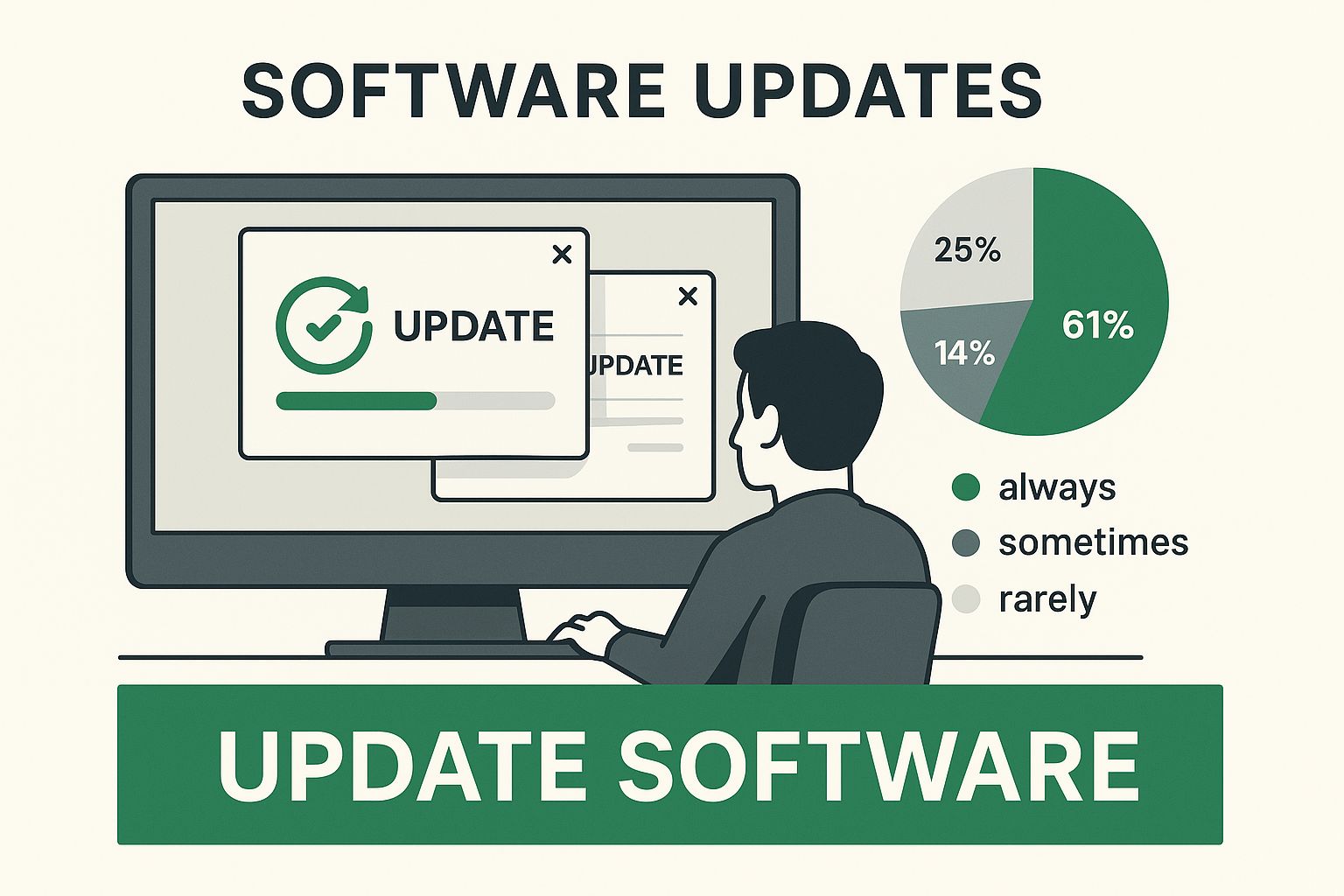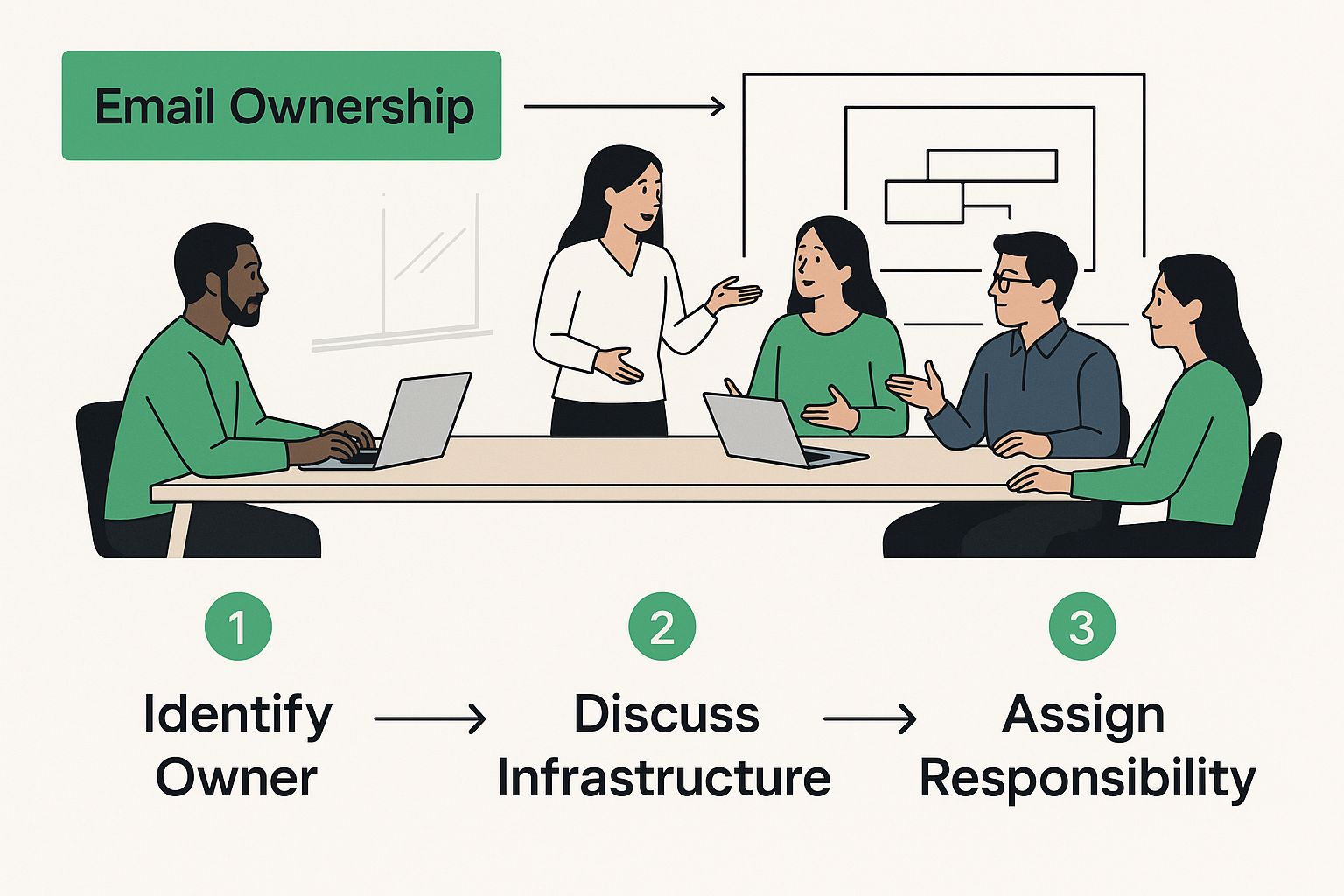When it comes to stopping ransomware, you have to start with your email. It's the #1 way attackers get in the door. The best defense is a two-pronged approach: a rock-solid, secure hosted email platform combined with smart, well-trained users who know how to spot a threat. Nail this, and you’ve built the foundation for a truly effective anti-ransomware strategy.
Why Your Inbox Is Ransomware’s Front Door
To build a real defense, you first need to understand the battlefield. Your inbox isn't just for sending and receiving messages; to an attacker, it's a wide-open highway leading straight to your company's most critical systems. Most ransomware attacks don't kick off with some sophisticated, movie-style hack. They start with a simple, cleverly disguised email.
And we're not talking about those old, poorly written phishing scams anymore. Modern attacks use highly targeted social engineering to create a false sense of trust and urgency. Think about getting an email that looks exactly like an invoice from a supplier you work with every week, or a frantic message from your CEO demanding an immediate wire transfer. These emails are designed to prey on human nature, pushing you to make one quick, catastrophic click.
How an Email Attack Unfolds
The process is disturbingly simple, yet it works time and time again. It all starts when someone on your team gets a carefully crafted email carrying either a malicious link or a weaponized attachment.
- Malicious Links: A single click can take you to a login page that looks completely legitimate but is actually designed to steal your credentials. Once they have those, attackers can just walk right in.
- Infected Attachments: Opening what looks like a harmless PDF invoice or a Word document can trigger a hidden script, which then quietly downloads the ransomware onto the network.
Once it's running, the malware gets to work encrypting everything it can find, grinding your entire operation to a halt. The key takeaway here is that email security isn't just an IT task to check off a list—it's a core business function. To get better at this, everyone needs to learn how to identify phishing emails with expert tips to stay safe.
The financial stakes are absolutely massive. Globally, cybercrime is expected to cost businesses a mind-boggling $10.5 trillion annually by 2025. That number isn't just the ransom itself; it includes the cost of recovery, lost business, and damage to your reputation. You can dig deeper into the staggering costs of cybercrime to see the full picture.
Developing Smarter Email Habits

All the best firewalls in the world won't save you if someone on your team clicks the wrong link. That single moment of human error is what attackers count on, which is why your "human firewall" is arguably your most important defense.
This isn't just about repeating the old advice to "not click strange links." It’s about building the right kind of muscle memory—a healthy, automatic skepticism—to spot and neutralize threats before they ever have a chance to launch. Attackers are masters of psychological manipulation, using urgency and fear to rush you into a mistake. Slowing down is your first line of defense.
Scrutinize Every Sender
Before you read a single word of the email body, look at who it's from. Attackers love to use domain spoofing, a tactic where an email address looks right at first glance but is intentionally misspelled. Think accounting@yourcompanny.com instead of accounting@yourcompany.com. It's a classic trick that still works.
Get in the habit of hovering over the sender's name to see the full email address behind it. Watch out for these red flags:
- Sneaky character swaps: Using a "1" for an "l" or "rn" to look like an "m" (
arnazoninstead ofamazon). - Wrong top-level domains: A message from
service@microsoft.cois not the same as one fromservice@microsoft.com. - Public email accounts: Your bank will never send you a password reset link from a
@gmail.comor@outlook.comaddress. Period.
Spotting these details is a fundamental skill. It helps shift your team's mindset from being potential victims to being active defenders. This cultural change is a big piece of what's covered in your guide to information security awareness training.
Safely Inspect Links and Attachments
Never, ever click a link or open an attachment without a second thought. A hyperlink can easily be disguised to say one thing but lead you somewhere else entirely. Instead of blindly clicking, just hover your mouse over the link. Your browser or email client will show you the real destination URL, usually in the bottom-left corner. If it looks fishy or doesn't match where you expect to go, just delete the email.
Attachments are even more dangerous. What looks like an innocent invoice PDF or a simple Word doc could actually be an executable file in disguise, ready to install ransomware the second it's opened.
If an attachment shows up unexpectedly—even if it's from a colleague or a trusted vendor—don't open it. Their account could be compromised. Pick up the phone or send them a message on a separate platform (like Teams or Slack) to confirm they actually sent it. This simple "trust but verify" habit can stop an attack in its tracks.
Choosing Your Hosted Email Platform
Your email habits are one part of the ransomware puzzle, but the technology running your inbox is just as critical. The hosted email platform you choose isn't just a mailbox; it's a fundamental layer in your defense. Think of it as the difference between a simple deadbolt and a full-blown security system for your digital front door.
Not all hosted email platforms are created equal. Standard services and truly secure, privacy-focused platforms are built on entirely different philosophies. While giants like Google Workspace and Microsoft 365 offer robust security, they also scan your data for advertising and product development. On the other hand, privacy-first providers like ProtonMail build their entire architecture around zero-knowledge principles, meaning not even the company can access your data.
Differentiating Security Features
When you're evaluating a hosted email platform, it's easy to get distracted by storage space and a slick interface. But to truly defend against ransomware, you need to dig deeper and focus on the features that actively hunt for and neutralize threats before they ever land in your inbox.
Here are a few non-negotiable features I always look for:
- Attachment Sandboxing: This is a game-changer. Instead of just a basic virus scan, the platform opens attachments in a secure, isolated virtual environment (a "sandbox"). It then watches what the file does. If it tries to encrypt files or call home to a malicious server, it's flagged and blocked.
- Advanced Link Protection: You'll sometimes see this called URL rewriting. When you click a link, the service checks it in real-time against a constantly updated list of malicious sites. This is crucial for catching delayed attacks, where a link is harmless at first but is later weaponized.
- Data Loss Prevention (DLP): While often used to stop employees from leaking sensitive data, DLP can also spot the tell-tale signs of a ransomware attack. These systems can flag unusual activity, like someone trying to download or access thousands of files at once—a common precursor to the encryption stage.
Choosing the right platform is about prioritizing tangible security value over simple familiarity. It’s an active decision to fortify your primary communication channel, which is absolutely essential for anyone serious about protecting their systems from ransomware.
Mainstream Platforms vs. Privacy-First Alternatives
There's no denying that Google Workspace and Microsoft 365 dominate the business email landscape. Their security suites, especially in the higher-tier plans, are incredibly powerful and benefit from the massive amount of threat data they process every second.
However, privacy-focused platforms like ProtonMail offer a different, compelling approach. They are often built from the ground up on end-to-end encryption, a method that ensures a message is scrambled on the sender's device and can only be unscrambled by the intended recipient. This architecture inherently shields your email content from prying eyes—including the provider's. The trade-off is that because the provider cannot scan your email content, some automated threat detection features that rely on content analysis may be less effective.
This developer's desktop serves as a great reminder that even with advanced platform security, the basics—like updating your software—are still critically important.

This image really drives home the point: your platform's features and your own security habits have to work together.
The table below provides a quick look at how these different platform types stack up when it comes to key security features that help stop ransomware.
Comparing Hosted Email Platform Security Features
| Security Feature | Google Workspace | Microsoft 365 | Privacy-Focused Platforms (e.g., ProtonMail) |
|---|---|---|---|
| Attachment Sandboxing | Available (Security Sandbox) | Available (Safe Attachments) | Less common; focus is on encryption, not active threat analysis |
| Advanced Link Protection | Available (Enhanced pre-delivery checks) | Available (Safe Links) | Varies; some offer phishing protection, but not always as advanced |
| Data Loss Prevention (DLP) | Included in higher-tier plans | Included in higher-tier plans | Generally not a core feature |
| End-to-End Encryption | Limited (requires specific configuration) | Limited (requires specific configuration) | Core feature; often enabled by default between platform users |
| Phishing/Spam Filtering | Advanced; uses machine learning | Advanced; uses machine learning | Strong, with a focus on privacy-preserving methods |
As you can see, the major platforms offer more active threat-hunting tools, while privacy-focused alternatives excel at protecting the data itself.
While end-to-end encryption alone won't stop you from clicking a malicious link, the "privacy-by-design" philosophy of these platforms often leads to stricter filtering and a smaller overall attack surface. For many organizations, the best solution is a hybrid one: use a major platform and enhance it with a specialized security layer. You can explore some of the top email filtering solutions for enhanced inbox security to see how this layered approach gives you the best of both worlds.
Configuring Advanced Email Defenses
Choosing a secure email platform is a great start, but it's just the foundation. Now, it's time to add the steel reinforcements that turn that foundation into a genuine fortress. This means setting up specific technical protocols that make your email domain a miserable place for attackers trying to impersonate you.
These configurations aren't just "nice-to-haves" anymore; they're essential pieces of modern email security. Think of them as digital bouncers at the door, constantly checking IDs to make sure every email claiming to be from you is the real deal. It’s this proactive stance that truly separates a vulnerable organization from a resilient one.
Building Your Wall with SPF, DKIM, and DMARC
You've probably seen these acronyms—SPF, DKIM, and DMARC—thrown around. But what do they actually do? In short, they work together as a three-part authentication system to stop attackers from sending emails that look like they came from your domain. This tactic, known as domain spoofing, is a favorite trick of ransomware gangs.
Here’s a quick, no-nonsense breakdown:
- SPF (Sender Policy Framework): This is basically a public list you create that tells the world which mail servers are allowed to send emails for your domain. It’s like a security guard checking a delivery driver's ID against an approved list before letting them in.
- DKIM (DomainKeys Identified Mail): This adds a tamper-proof digital signature to every email you send. The receiving server checks this signature to confirm the message wasn't altered on its way over.
- DMARC (Domain-based Message Authentication, Reporting, and Conformance): DMARC is the policy enforcer. It ties SPF and DKIM together and tells other mail servers what to do with messages that fail the checks. You can tell them to quarantine suspicious emails, reject them outright, or just let them through while you monitor the reports.
Putting all three in place closes a massive loophole that ransomware operators absolutely love to exploit.
Key Takeaway: Getting SPF, DKIM, and DMARC configured correctly is one of the most powerful technical moves you can make to shut down phishing. It makes it incredibly hard for criminals to impersonate your brand, which protects both your team and your customers from bogus emails.
Making Multi-Factor Authentication Non-Negotiable
If you only do one thing after reading this guide, make it this: enforce Multi-Factor Authentication (MFA) on every single email account. Period. No exceptions. Most ransomware attacks kick off with a compromised account, usually after a clever phishing email tricks an employee into giving up their password.
MFA puts a second, critical barrier in front of the attacker. Even if they manage to steal a password, they still need something they don't have—access to that person's phone or a fingerprint scan—to get in. This one step can single-handedly neutralize the threat of stolen credentials.
This is more important than ever. Ransomware incidents targeting industrial sectors alone saw over 657 documented attacks worldwide in just the second quarter of 2025. You can get a deeper look at these trends by exploring the latest industrial ransomware analysis from Dragos.
Implementing Custom Email Filtering Rules
Your hosted email platform comes with some pretty good spam filters, but you can—and should—dial them in for even better protection. By creating your own custom filtering rules, you can automatically flag or quarantine emails with the tell-tale signs of a ransomware campaign.
Think about setting up rules that:
- Block risky file types: Automatically send any email with an executable attachment (
.exe,.scr, etc.) or a password-protected.zipfile straight to quarantine. - Flag high-pressure language: Create a rule that sticks a big warning banner on any email with phrases like "Urgent Request," "Payment Overdue," or "Immediate Action Required."
- Isolate messages from new senders: You can set up your system to hold messages from domains you’ve never communicated with before, giving you or your IT team a chance to review them first.
These custom rules act as an intelligent, automated line of defense, catching threats that standard filters might miss.
Creating Your Ransomware Recovery Plan

Let's be realistic: even with the best defenses, a determined attacker might still find a way in. When that day comes, your ability to recover your data and get back to business is what separates a minor headache from a company-ending disaster.
A well-crafted recovery plan is your ultimate insurance policy. It's the ace up your sleeve that makes paying a ransom completely unnecessary. The heart of this plan isn't complicated technology; it's a disciplined, robust backup strategy. We're not talking about just copying a few files here and there. We're talking about building a resilient system that can withstand a direct assault from criminals who want to destroy your safety nets.
The Proven 3-2-1 Backup Rule
For decades, the gold standard in data protection has been the 3-2-1 backup rule. It’s a simple concept, but its power lies in the layers of redundancy it creates. Following this framework makes it incredibly difficult for any single event—whether it's a ransomware attack or a physical disaster—to wipe you out completely.
Here’s the breakdown:
- Three Copies of Your Data: You need the original, live data plus at least two separate backups. If one fails, you still have another.
- Two Different Media Types: Don't put all your eggs in one basket. Store your backups on two distinct types of storage, like an on-site network drive and a separate cloud storage account.
- One Copy Off-Site: This is critical. At least one of your backups must live in a completely different physical location. This protects you from a localized event like a fire, flood, or a ransomware strain that spreads across your entire local network.
This multi-layered approach means that even if attackers compromise your network and encrypt your local backups, that off-site or cloud copy remains untouched and ready for recovery. To take this a step further, many businesses are now building out a modern Disaster Recovery solution to automate and speed up this entire process.
Your Ultimate Safety Net: Immutable Backups
Cybercriminals are smart. They know you have backups, and they’ve made a habit of targeting them first. In fact, a staggering 96% of ransomware attacks now actively try to find and destroy backup repositories before encrypting primary systems.
This is where immutable backups become your most powerful weapon. Think of immutability as a digital lockbox with a time lock. Once a backup is written, it's set in stone—it cannot be changed or deleted by anyone, not even an administrator with full credentials, until a predetermined time has passed.
So, even if an attacker gets deep into your systems, they simply can't touch these unchangeable copies. It's the ultimate failsafe.
An untested backup is just a hope, not a plan. You absolutely must test your restores regularly. Schedule it, practice it, and make sure you can actually bring your systems back online from your backups. Finding out your backups are corrupted or incomplete in the middle of a real crisis is a nightmare you don't want to live.
Your Top Email Security Questions, Answered
Even with the best defense in place, you're bound to have questions. Let's clear up some of the most common concerns I hear about email security and its role in ransomware attacks. Getting straight answers is the best way to turn good advice into solid action.
Can I Get Ransomware Just by Opening an Email?
This is a big one, and thankfully, the answer is probably not. Modern email clients have come a long way. Simply opening and reading an email is extremely unlikely to infect your computer.
The real danger kicks in when you interact with something inside the email. Ransomware needs you to do something to let it in. This usually means:
- Clicking a malicious link that sneakily downloads malware in the background.
- Opening an infected attachment disguised as something innocent, like a PDF invoice, a shipping update, or a Word document.
Think of it this way: the risk isn't in seeing the email; it's in acting on what it asks you to do.
Is a Free Email Service Like Gmail Good Enough?
For personal use, services like Gmail and Outlook provide a surprisingly solid layer of security, especially if you have Multi-Factor Authentication (MFA) turned on. They scan billions of emails, so they're great at filtering out obvious spam and known threats.
But for a business, it’s a different story. If you're handling sensitive customer info or financial data, relying on a free service is a gamble. Upgrading to a paid plan like Google Workspace or Microsoft 365 isn't just a nice-to-have; it's essential.
These business-grade platforms offer advanced threat protection, granular admin controls, and security protocols like DMARC enforcement that are built to stop the kind of targeted, sophisticated attacks that businesses face. It's a level of defense free services just can't provide.
The single best thing you can do to protect any email account—free or paid—is to enforce Multi-Factor Authentication. Most ransomware attacks start with a compromised account. Even if an attacker successfully phishes your password, MFA acts as a digital deadbolt. It requires a second code, usually from your phone, that the bad guy doesn't have. This one simple step can stop an account takeover in its tracks.
Choosing the right email platform is foundational to protecting your organization from ransomware. It's the secure bedrock upon which all your communications are built.
Ready to secure your communications with an email platform that prioritizes your privacy and security? Typewire offers a secure, ad-free, and no-tracking email experience built on our privately owned infrastructure. Start your free trial today and take back control of your inbox.





